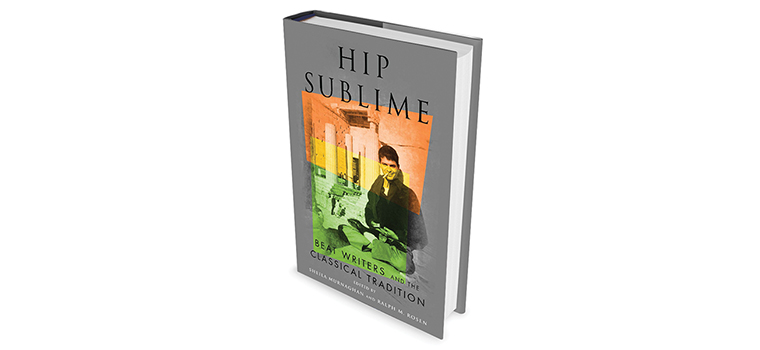As many of our readers know, ferries played a major role in much of classical literature, and specifically in tales of mythic journeys.

BY PAUL DUCLOS
Published: May, 2018
As many of our readers know, ferries played a major role in much of classical literature, and specifically in tales of mythic journeys. The River Styx, for example, had to be crossed to reach life after death and the only mode of transport was in a ferryboat rowed by Charon, an extortionist with leverage to spare.
The evil boatman would only take a soul if the owner’s body had received funereal rites on earth, and he demanded to be paid prior to embarkation. As a consequence, funeral rites of the Ancient Greeks included placing a small coin under the tongue of a dead person for this purpose. And you think your commute is Hell?
We were hoping to find more references to ferries when we began reading Hip Sublime: Beat Writers and the Classical Tradition, especially since the book’s premise means to support the movement’s formative appropriation of the Greek and Latin classics. We found many other reasons for enjoying this collection of essays, however.
Particularly engaging was the chapter on cult hero Charles Bukowski, who was a marginal Beat writer at best, but still among that generation who drank deeply from the classical trough. The chapter “Radical Brothers-in-Arms: Gaius and Hank at the Racetrack” explains how the author was enamored by the poetry of Catullus and came to regard him as a fellow traveler.
Essayist Marguerite Johnson writes that Bukowski may have just been loitering on the outside rail, but he still lived the Beat ideal.
You come right out and say things,
You’re not like the others; but listen, Catullus,
Didn’t I see you at the racetrack bar last Thursday?
For more information, see ohiostatepress.org.
Precisionism Exhibit at the De Young Museum
The San Francisco Bay Area has long been intrigued by cults of any and all kinds, so it should come as small surprise that the current exhibit at the De Young Museum is such a hit this year. The Cult of the Machine: Precisionism and American Art displays many images and artifacts dear to any ferry rider.
One of the more enchanting aspects of the show is found in the gallery featuring Precisionist views of the urban landscapes of the early twentieth century, replete with soaring skyscrapers and bridges, elevated train and subway tracks, and industrial waterways.
Ferry riders will note that this gallery also includes a screening of Charles Sheeler and Paul Strand’s short film Manhatta (1920), which showcases the early twentieth-century city as its subject. The first frames of the movie show a ferry boat teeming with passengers eager to disembark and begin their urban adventure.
The vertiginous bird’s-eye perspectives of many of the compositions in this gallery capture the dramatic scale of the buildings, which dominate the landscape both physically and metaphorically, towering over their human counterparts. Decorative art objects that were inspired by the vertical forms of the modern skyscraper are also on display.
“The responses to industrialization in these works are particularly fascinating and relevant to contemporary audiences who find themselves in the midst of a fourth industrial revolution,” said Emma Acker, associate curator of American art for the Fine Arts Museums. “They hold up a mirror to our own complicated responses to the legacies of industrialization and technological progress as we continue to navigate our relationships with the ever-multiplying devices that surround us and shape our daily existence.”
The catalogue, by the way, is extraordinary. In addition to making a meaningful contribution to the resurging interest in Modernism and its revisionist narratives, this book offers copious connections between the past and our present day, poised on the verge of a fourth industrial revolution.
For more information, see www.yalebooks.com and www.famsf.org.
SFJAZZ Releases New Recordings
When does a cult become a “collective”? That’s up for discussion at our next clambake, but meanwhile, consider the SFJAZZ Collective and give their new recording a listen. It’s hip. It’s sublime. And the musicians play like a well-oiled machine.
The ensemble’s 14th limited-edition set, SFJAZZ Collective Live: SFJAZZ Center 2017—Original Compositions and the Music of Ornette Coleman, Stevie Wonder and Thelonious Monk is available now. The single, “Give the Drummer Some,” debuted on April 6, with the full album following a week later. The SFJAZZ Collective will celebrate the album’s release at Jazz Standard in New York. Physical copies will include the 2CD set and a bonus DVD of live concert footage captured at the SFJAZZ Center in San Francisco.
Recorded over four nights at the SFJAZZ Center from October 26 to 29, 2017, this collection consists of one CD of new pieces composed by each member of the current SFJAZZ Collective, with a second CD of fresh versions of tunes from Ornette Coleman, Thelonious Monk and Stevie Wonder. These tunes appear on past releases and were arranged by former SFJAZZ Collective members include saxophonist Joshua Redman, trumpeter Dave Douglas, arranger Gil Goldstein and trumpeter Avishai Cohen.
For more information, see www.SFjazz.org.
Follow Paul Duclos’ Cultural Currents online with his blog at: www.duclosculturalcurrents.com

Installation view of “Cult of the Machine: Precisionism and American Art”. Image courtesy of the Fine Arts Museums of San Francisco.

